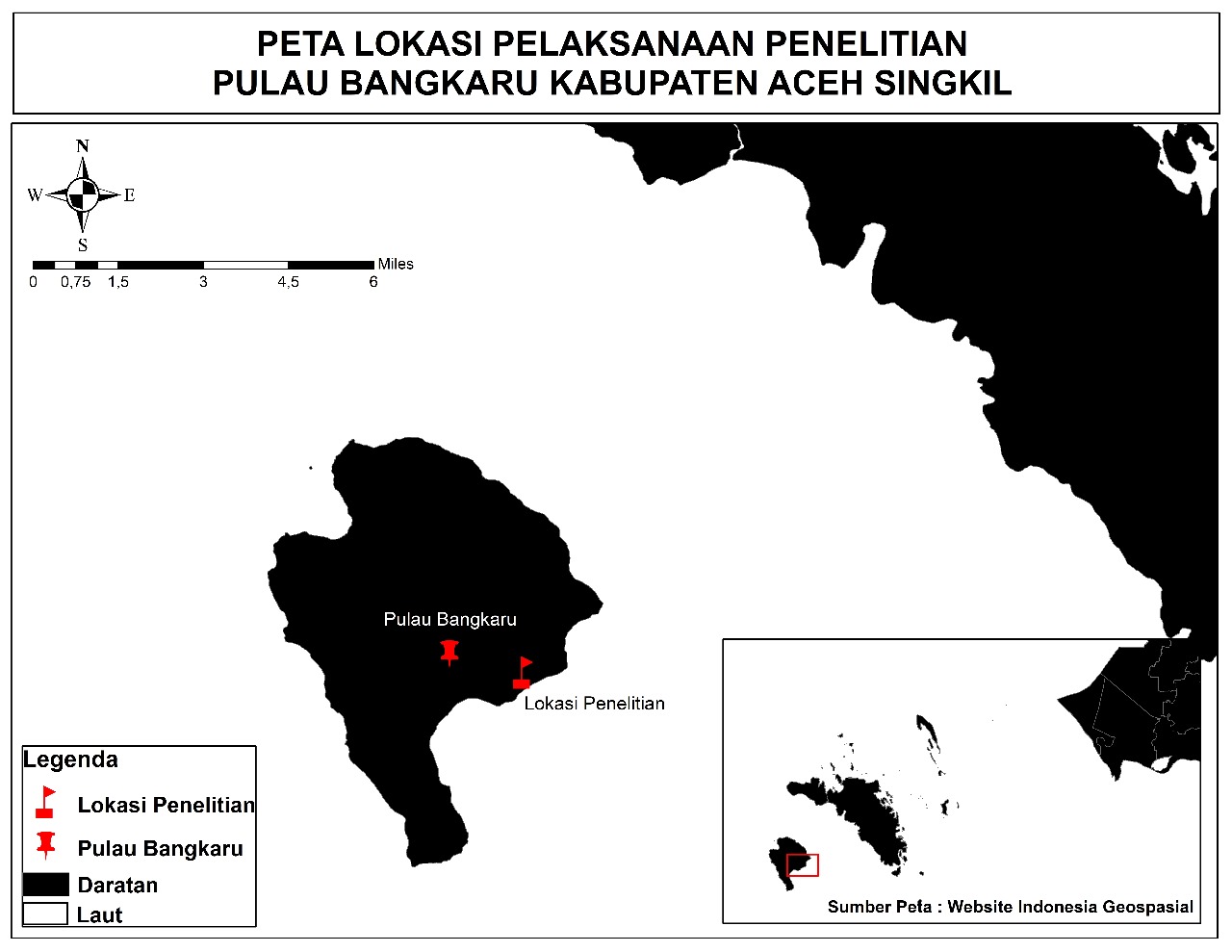Success Rate Of Hatching Of Green Turtle Eggs ( Chelonia Mydas) On Bangkaru Island, Banyak Island, Aceh Singkil
Main Article Content
Abstract
Turtles are biota that are included in the protected animal category because they have a high level of threat of extinction due to natural and anthropogenic factors. Turtles spend their time in the open sea and go ashore to lay their eggs each season. The successful hatching of turtle eggs is important as an effort to increase their population. This research aims to see the success rate of hatching of green turtle (Chelonia Mydas) eggs on Bangkaru Island, Banyak Island, Aceh Singkil. This research was carried out from March to June 2024. The research was carried out by observing at the green turtle nesting beach the number of nests, number of eggs, nest meters, percentage of hatched eggs. The method used in this research is a survey (direct observation). In the results of research that has been carried out, the highest percentage of turtle eggs is found in the 6th nest with a percentage of 48%, while the lowest percentage is found in nests 1, 2 and 4 with a percentage of 0%. The high percentage in the 6th nest is estimated because of the location. nest that is suitable for the nest, because the nest is directly exposed to the sun and is far from the ebb and flow of sea water which results in the nest being damp and the temperature of the nest remaining stable, the low hatching rate in nests 1, 2, and 4 is because the nest is close to the nest. The ebb and flow of sea water causes the nest to be flooded with sea water and the nest is not exposed to enough sunlight, which causes the eggs to rot in the nest.
Downloads
Article Details

This work is licensed under a Creative Commons Attribution 4.0 International License.
Allow anyone to modify, improve, and make derivative works, even for commercial purposes, as long as they credit to you for the original work.
References
Edwards, R. C., Godley, B. J., & Nuno, A. (2020). Exploring connections among the multiple outputs and outcomes emerging from 25 years of sea turtle conservation in Northern Cyprus. Journal for Nature Conservation, 55, 125816.
Fitriani, D., Zurba, N., Edwarsyah, N. M., & Munandar, R. A. (n.d.). Kajian Kondisi Lingkungan Tempat Peneluran Penyu Di Desa Pasie Lembang, Aceh Selatan Study Of The Environmental Conditions Of Turtle Breeding Places In Pasie Lembang Village, South Aceh.
Harnino, T., Parawangsa, I. N. Y., Sari, L. A., & Arsad, S. (2021). Efektifitas pengelolaan konservasi penyu di turtle conservation and education center Serangan, Denpasar Bali. Journal of Marine and Coastal Science Vol, 10(1), 242–255.
Kasenda, R. (2013). Kompensasi dan motivasi pengaruhnya terhadap kinerja karyawan pada PT. Bangun Wenang Beverages Company Manado. Jurnal EMBA: Jurnal Riset Ekonomi, Manajemen, Bisnis Dan Akuntansi, 1(3).
Pratama, A. A., & Romadhon, A. (2020). Karakteristik Habitat Peneluran Penyu Di Pantai Taman Kili-Kili Kabupaten Trenggalek dan Pantai Taman Hadiwarno Kabupaten Pacitan. Juvenil: Jurnal Ilmiah Kelautan Dan Perikanan, 1(2), 198–209.
Rachman, B. A., Firdaus, F. S., Mufidah, N. L., Sadiyah, H., & Sari, I. N. (2021). Peningkatan kemampuan literasi dan numerasi peserta didik melalui program kampus mengajar angkatan 2. DINAMISIA: Jurnal Pengabdian Kepada Masyarakat, 5(6), 1535–1541.
Rachman, M. R. (2021). Karakteristik habitat peneluran penyu lekang (lepidochelys olivacea) di pantai Cemara Banyuwangi. Universitas Islam Negeri Sunan Ampel.
Retni Agmalia, D., Syafwan, M. S., & San Ahdi, S. S. (2015). Perancangan Media Kampanye Konservasi Penyu Upt (Unit Pelaksana Teknis) Pariaman Dalam Bentuk Film Dokumenter. Dekave: Jurnal Desain Komunikasi Visual, 3(1).
Rofiah, A., Hartati, R., & Wibowo, E. (2012). Pengaruh naungan sarang terhadap persentase penetasan telur penyu lekang (Lepidochelys olivacea) di Pantai Samas Bantul, Yogyakarta. Journal Of Marine Research, 1(2), 103–108.
Sari, N. R., & Wahidahwati, W. (2018). Pengaruh Keputusan Investasi, Keputusan Pendanaan Dan Kebijakan Dividen Terhadap Nilai Perusahaan Dengan GCG Sebagai Variabel Moderating. Jurnal Ilmu Dan Riset Akuntansi (JIRA), 7(6).
Sepawan, M. (2018). Pengaruh Struktur Dan Komposisi Vegetasi Pantai Terhadap Pendaratan Penyu (Chelonioidea) Di Pekon Muara Tembulih Kecamatan Ngambur Kabupaten Pesisir Barat. Uin Raden Intan Lampung.
Sheavtiyan, T. R. S., & Lovadi, I. (2014). Tingkat keberhasilan penetasan telur penyu hijau (Chelonia mydas, Linnaeus 1758) di Pantai Sebubus, Kabupaten Sambas. Protobiont, 3(1).
Sihaan, H. P., Wawan, W., & Khoiri, M. A. (2023). Intensity Of Soil Treatment And Frequency Of Inorganic Fertilizer Application On Nutrient Levels And Growth Of Palm Oil (Elaeis guineensis Jacq) At The Replanting Stage. Jurnal Agronomi Tanaman Tropika (Juatika), 5(1), 281–290.
Sinaga, R. R. K., Hanif, A., Kurniawan, F., Roni, S., Laia, D. Y. W., & Hidayati, J. R. (2024). Tingkat Keberhasilan Penetasan Telur Penyu Hijau (Chelonia mydas) dan Penyu Sisik (Eretmochelys imbricata) Di Pulau Mangkai Kepulauan Anambas. Journal of Marine Research, 13(1), 92–99.
Syaputra, L. I., Mardhia, D., & Syafikri, D. (2020). Karakteristik Habitat Peneluran Penyu di Calon Kawasan Konservasi Perairan Taman Pesisir Lunyuk dan Tatar Sepang. Indonesian Journal of Applied Science and Technology, 1(2), 55–63.
S. Bahri, A. S. Atmadipoera, and H. H. Madduppa, “Keragaman genetik penyu lekang Lepidochelys olivacea dengan pola arus di teluk Cendrawasih, Papua,” J. Ilmu dan Teknol. Kelaut. Trop., vol. 9, no. 2, pp. 747–760, 2017.
Tambun, S., & Kopong, Y. (2017). The Effect of E-Filing on The of Compliance Individual Taxpayer, Moderated By Taxation Socialization. South East Asia Journal of Contemporary Business, Economics and Law, 13(1), 45–51.
T. Harnino, I. N. Y. Parawangsa, L. A. Sari, and S. Arsad, “Efektifitas pengelolaan konservasi penyu di turtle conservation and education center Serangan, Denpasar Bali,” J. Mar. Coast. Sci. Vol, vol. 10, no. 1, pp. 242–255, 2021.
Winarto, W., & Azahra, S. D. (2022). Karakteristik dan Preferensi Habitat Penyu dalam Membuat Sarang Alami untuk Peneluran. Bioedusains: Jurnal Pendidikan Biologi Dan Sains, 5(1), 189–196

